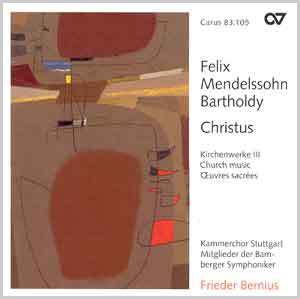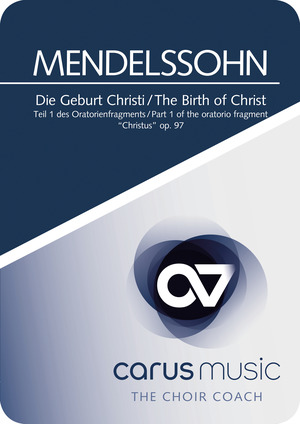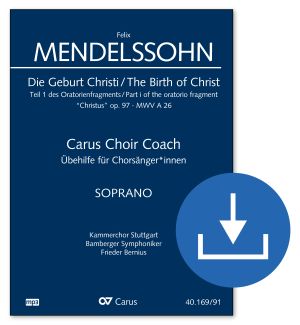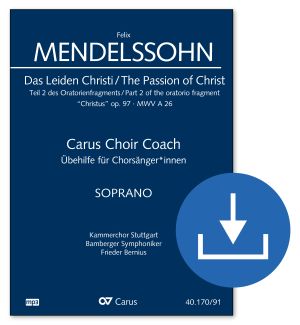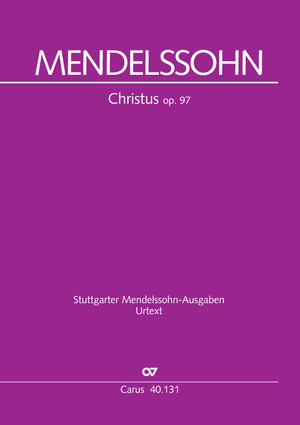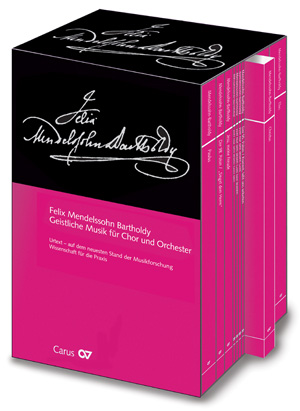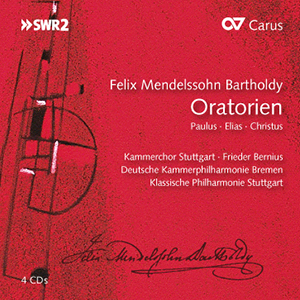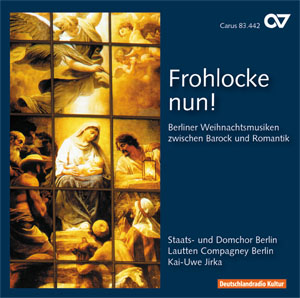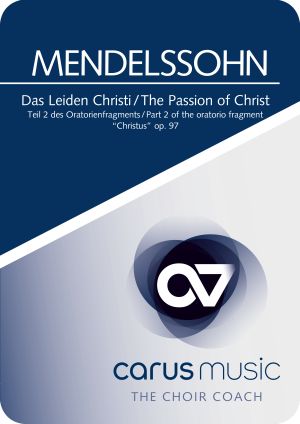
Christus
Oratorio fragament. Part I: The Birth of Christ; Part II: The Passion of Christ MWV A 26 (Op. 97), 1847
Christus is a fragment of an oratorio which Mendelssohn never completed. He had probably planned a third section to follow the two sections Die Geburt Christi and Das Leiden Christi. Das Leiden Christi essentially comprises compact choral sections which alternate with short recitatives. Here, two choral groups frequently sing in dialog and interrupt each other with "hin und her" ("near and far") and "kreuzige, kreuzige" ("crucify"). There is no time to read the notes or count the beats – the entries must fit together!
Performers: Dorothea Rieger (soprano), Monika Meier-Schmid (soprano), Isolde Assenheimer (alto), Mechthild Seitz (alto), Stephan Dürr (tenore), Bernhard Scheffel (tenore), Johannes Happel (baritone), Cornelius Hauptmann (basso), Adolph Seidel (basso) – Kammerchor Stuttgart, Bamberger Symphoniker – Frieder Bernius
Simply practice. Anytime. Everywhere.
Whether at home on your tablet or PC or on the road on your smartphone: with carus music, the Choir Coach, you always have your choral works with you to practice! With the carus music choir app, you can listen to your score together with a first-class recording on any device and easily practice your own choir part with a coach. With carus music, your concert preparation is easy, efficient and fun to master!
Whether at home on your tablet or PC or on the road on your smartphone: with carus music, the Choir Coach, you always have your choral works with you to practice! With the carus music choir app, you can listen to your score together with a first-class recording on any device and easily practice your own choir part with a coach. With carus music, your concert preparation is easy, efficient and fun to master!
Performers: Dorothea Rieger (soprano), Monika Meier-Schmid (soprano), Isolde Assenheimer (alto), Mechthild Seitz (alto), Stephan Dürr (tenore), Bernhard Scheffel (tenore), Johannes Happel (baritone), Cornelius Hauptmann (basso), Adolph Seidel (basso) – Kammerchor Stuttgart, Bamberger Symphoniker – Frieder Bernius
Purchase
Additional product information
Contents
-
Composer
Felix Mendelssohn Bartholdy
| 1809-1847
-
Choir
Kammerchor Stuttgart
The Kammerchor Stuttgart is regarded as one of the best ensembles of its kind. Over its fifty-year existence, Frieder Bernius has developed the choir into an exceptional ensemble acclaimed by audiences and press alike. This has led to invitations for the choir to perform at all the important European festivals. In Germany the chamber choir performs at festivals and in concert halls in repertoire ranging from the 17th to the 21st century. Frieder Bernius and his ensemble have received numerous accolades for their contribution to new music. The Kammerchor Stuttgart has made over 80 CDs and LPs, numerous of which have been awarded international recording prizes (including the Edison award, Diapason d’or, Gramophone Choice, Classical Internet Award, International Classical Music Award, and German Record Critics’ Award prizes). The International Federation for Choral Music has invited the ensemble to sing at the 1st, 4th and 10th World Symposia on Choral Music in Vienna, Sydney and Seoul. Regular tours of North America and Asia since 1988 and a South America tour reflect the Kammerchor Stuttgart’s international reputation. Since 1984 the top ensemble has also been invited to Israel biennially. Personal details
-
Ensemble
Bamberger Symphoniker
Mitglieder der Bamberger Symphoniker Personal details
-
Soloist - soprano
Monika Meier-Schmid
-
Soloist - soprano
Dorothea Rieger
-
Soloist - alto
Isolde Assenheimer
-
Soloist - alto
Mechthild Seitz
-
Soloist - tenor
Bernhard Scheffel
-
Soloist - baritone
Johannes Happel
-
Soloist - bass
Cornelius Hauptmann
| 1951
-
Soloist - bass
Adolph Seidel
Adolph Seidel studied singing with Peter Wetzler and Paul Lohmann. He specializes in music of the early and high Baroque. As well as bass roles in concert repertoire, he particularly enjoys ensemble singing. Reflecting this, since 1977 he has been a member of the Kammerchor Stuttgart, the sixteen soloists of the Kammerchor Stuttgart under Frieder Bernius and the KammerChor Saarbrücken, and has been the bass in the Orlando di Lasso-Ensemble for several years. As well as his work as a singer, he is director of the vocal ensemble VocArt, specializing in the performance of Baroque vocal music ranging from small-scale works for soloists to oratorio works. Personal details
Frequent questions about this work
 There are no questions and answers available so far or you were unable to find an answer to your specific question about this work? Then click here and send your specific questions to our Customer Services!
There are no questions and answers available so far or you were unable to find an answer to your specific question about this work? Then click here and send your specific questions to our Customer Services!


